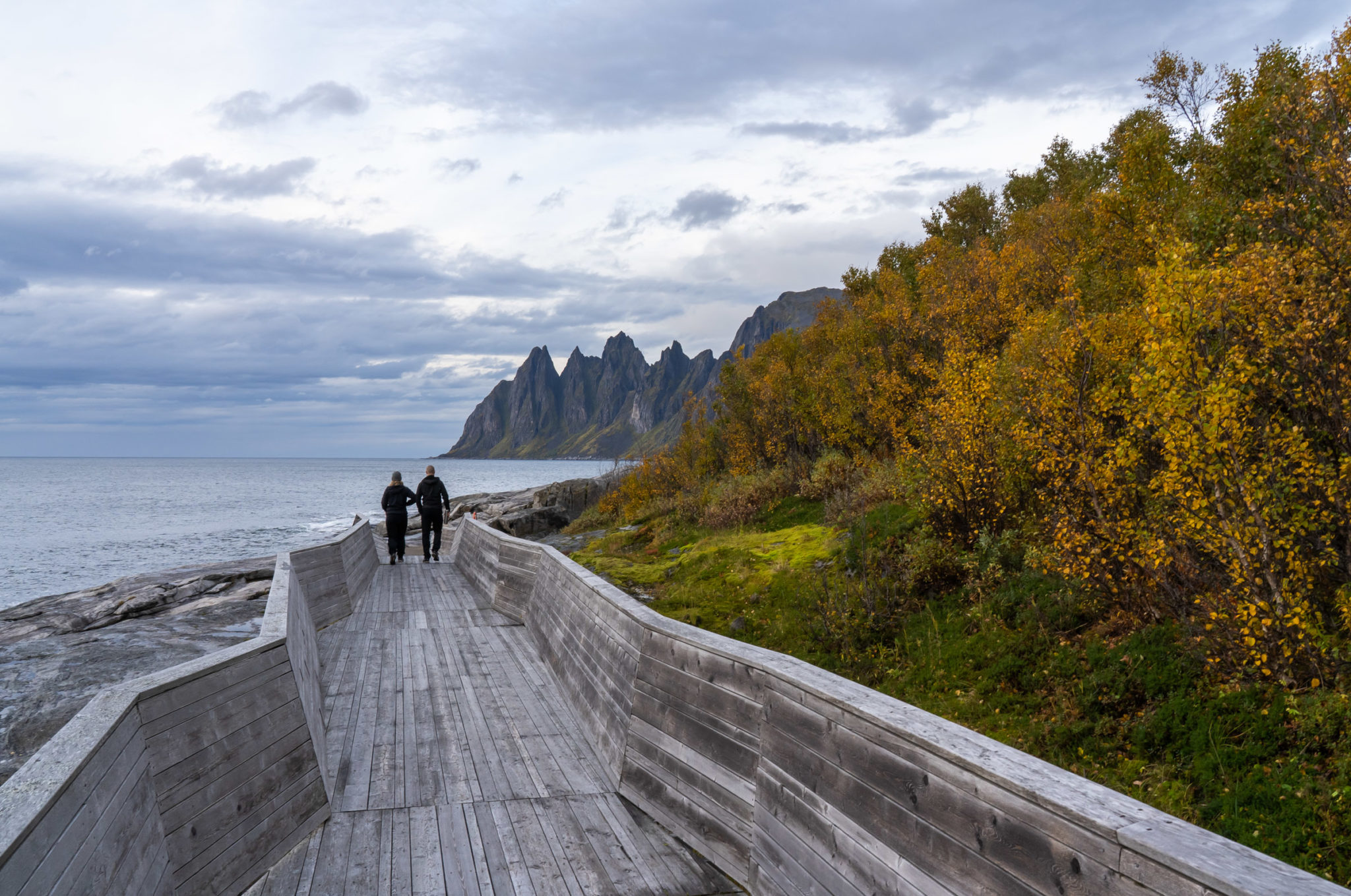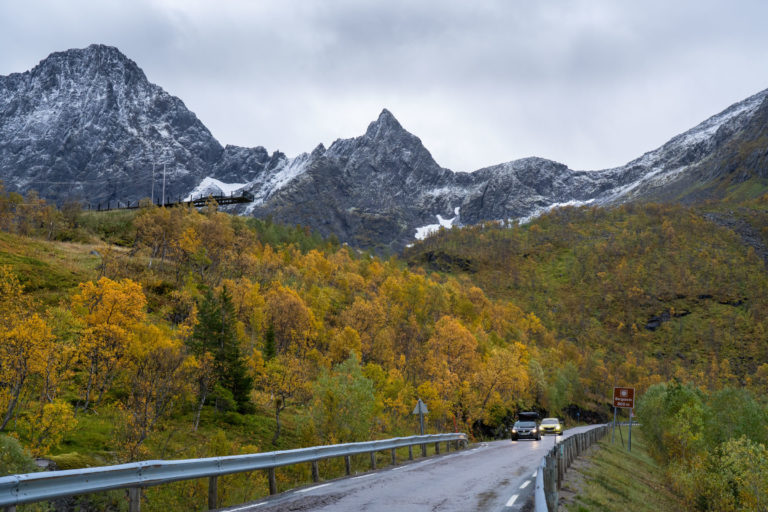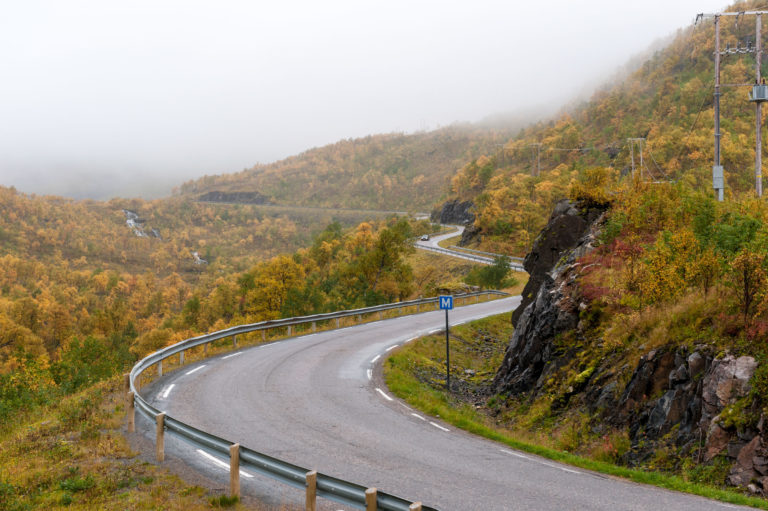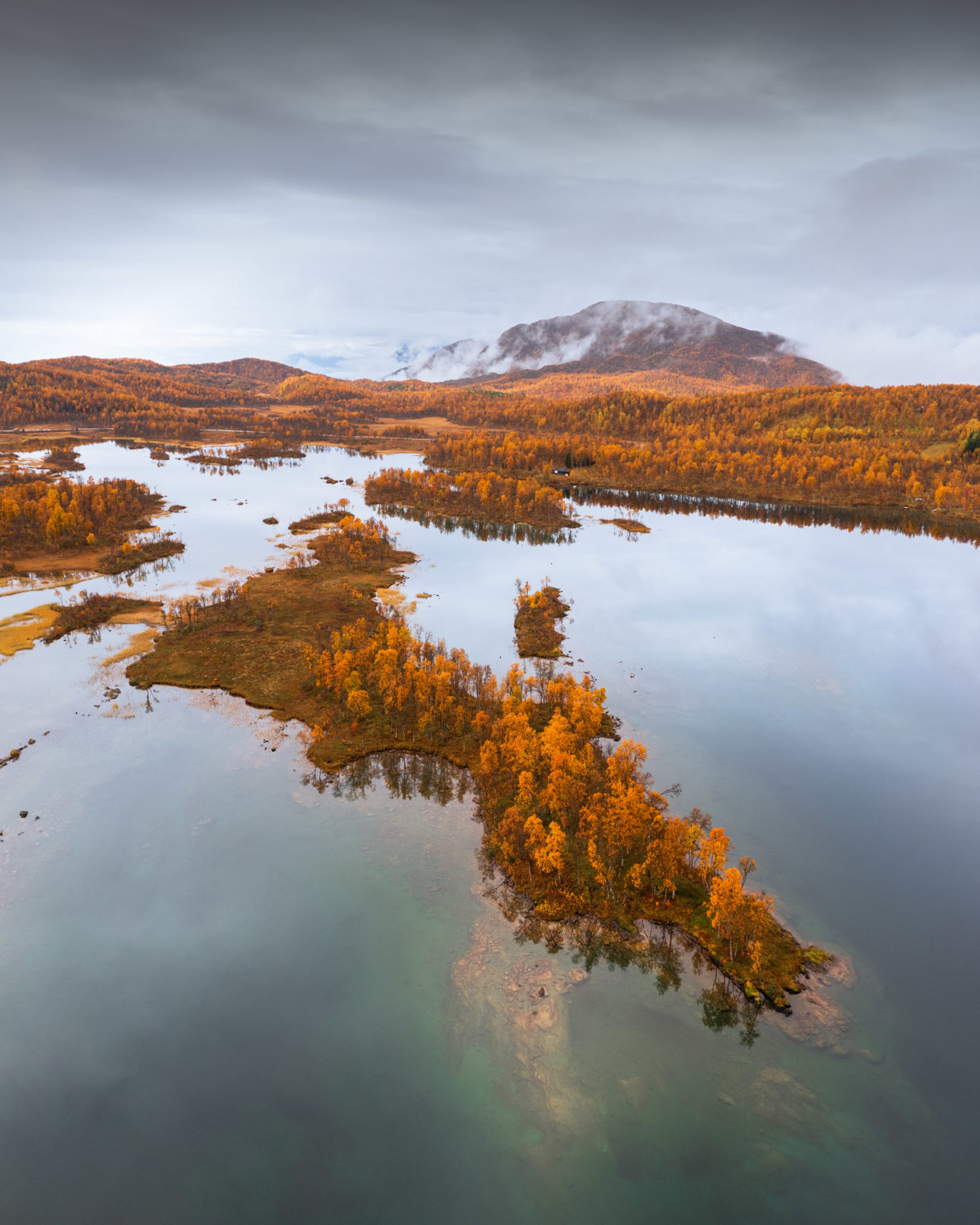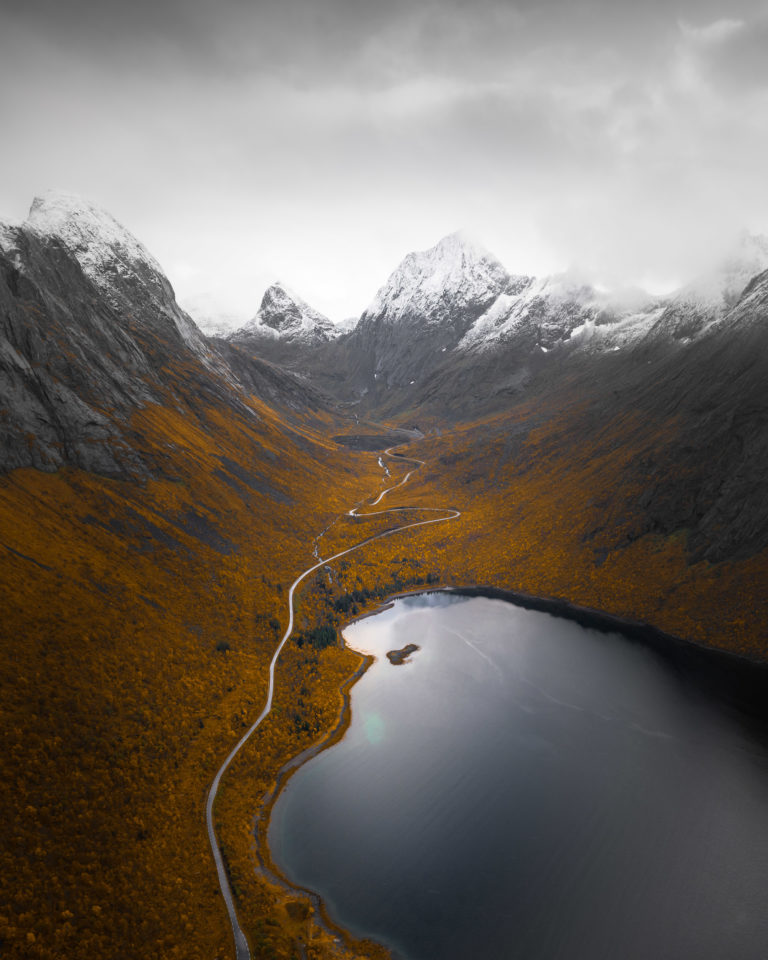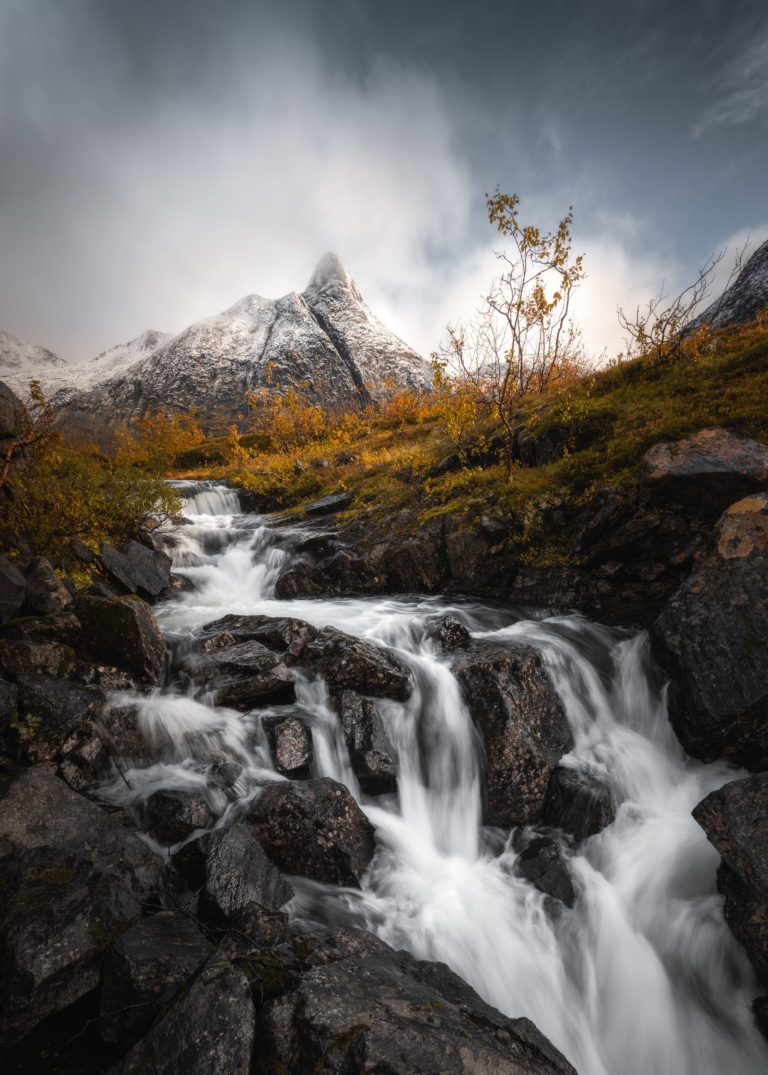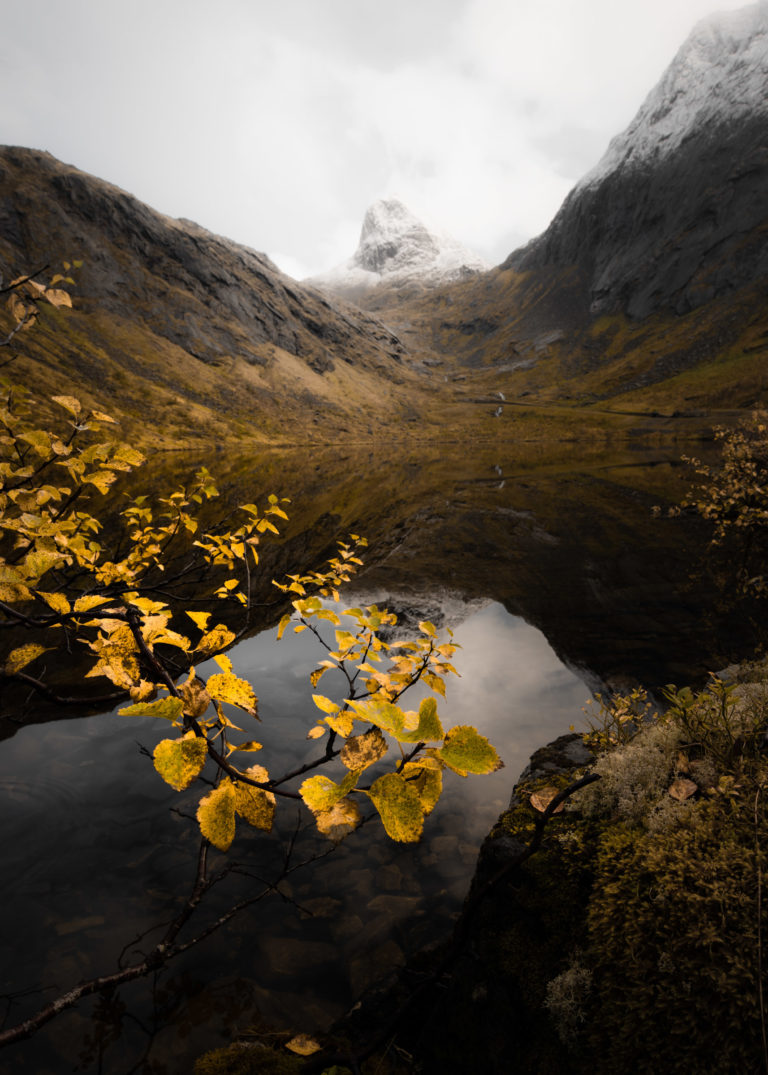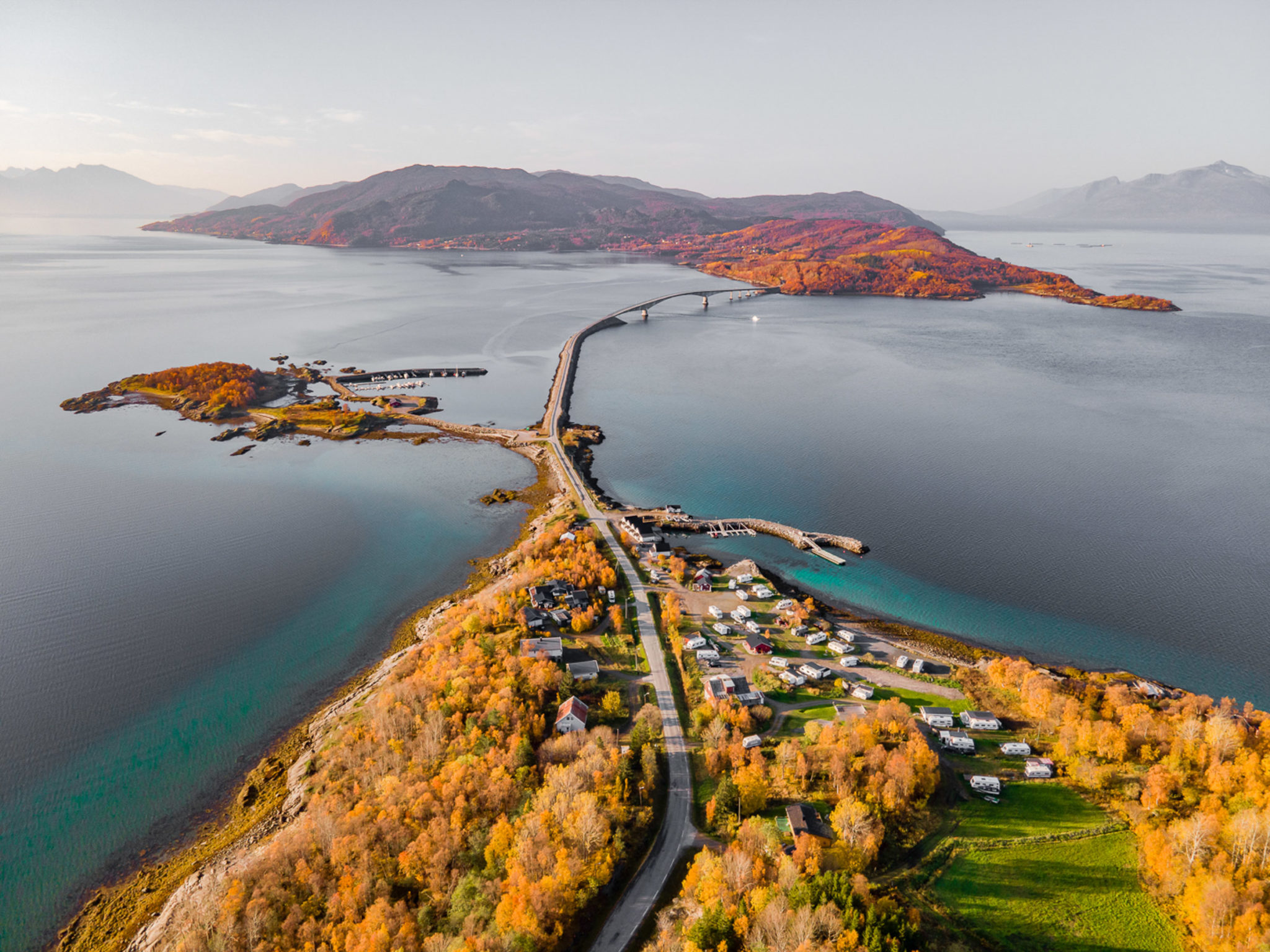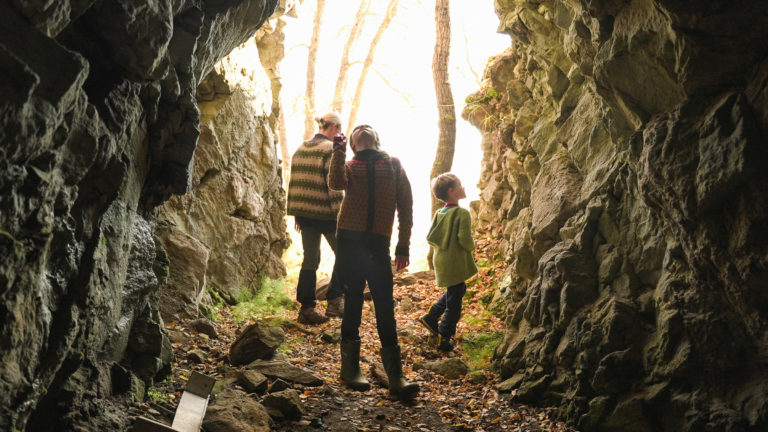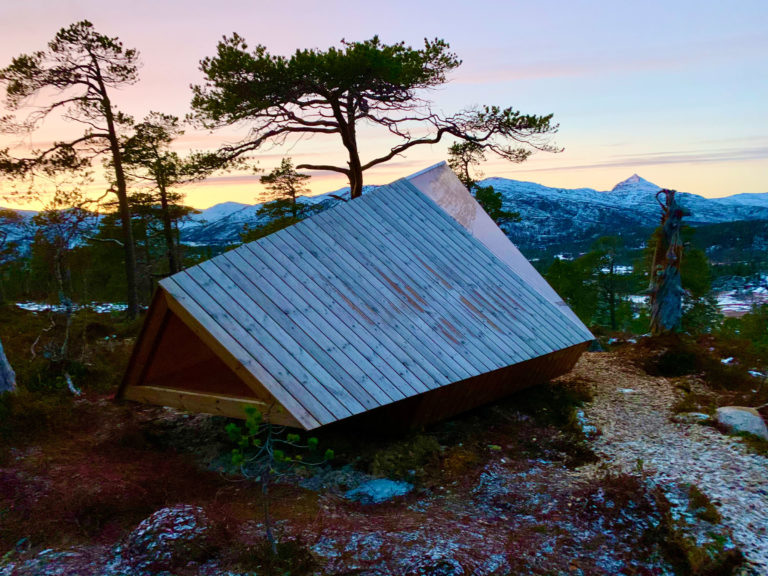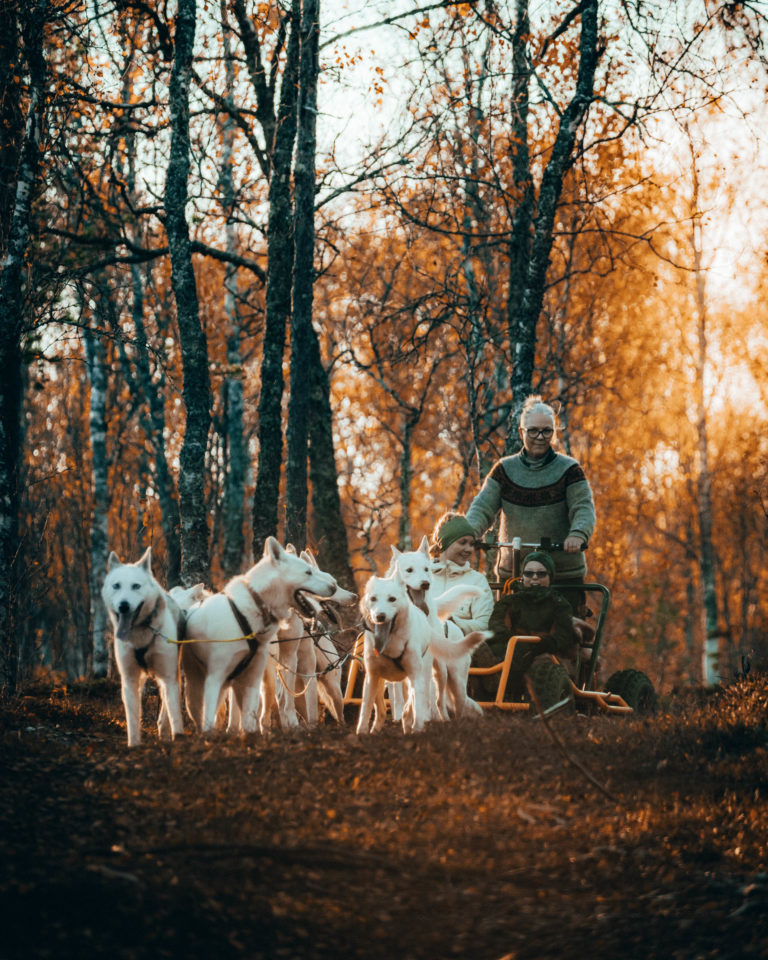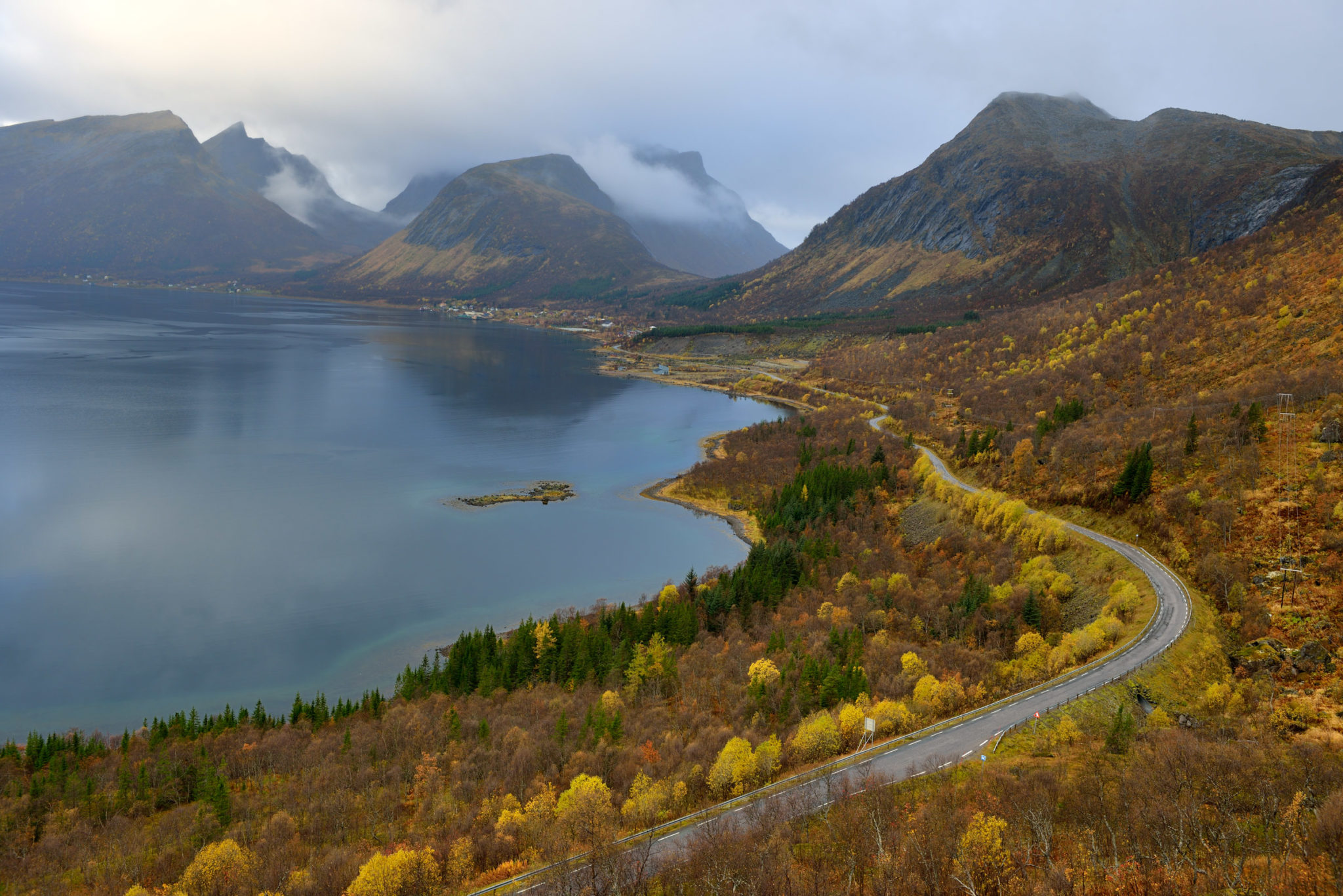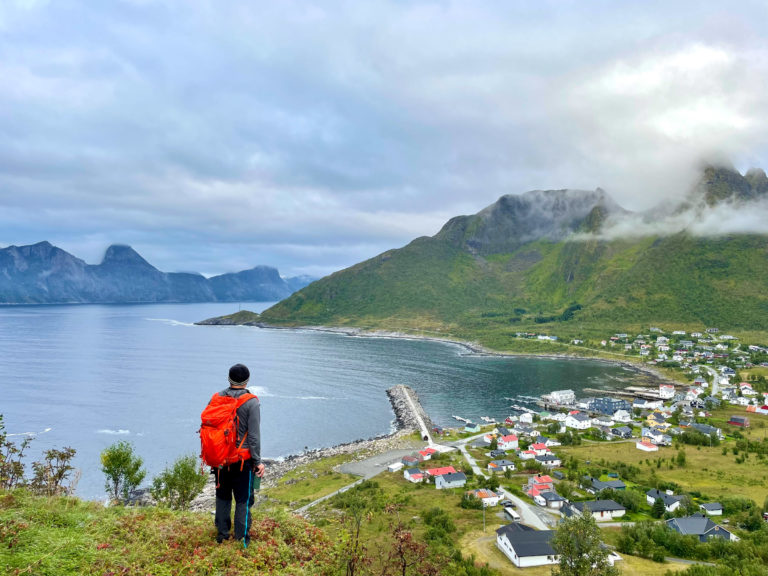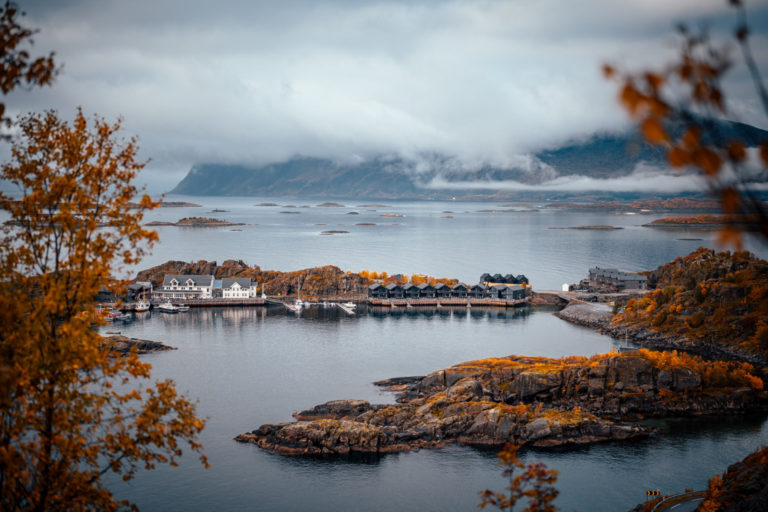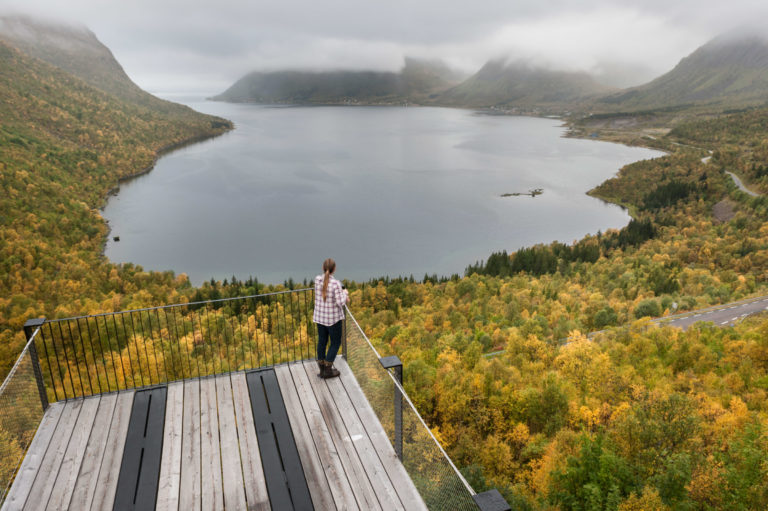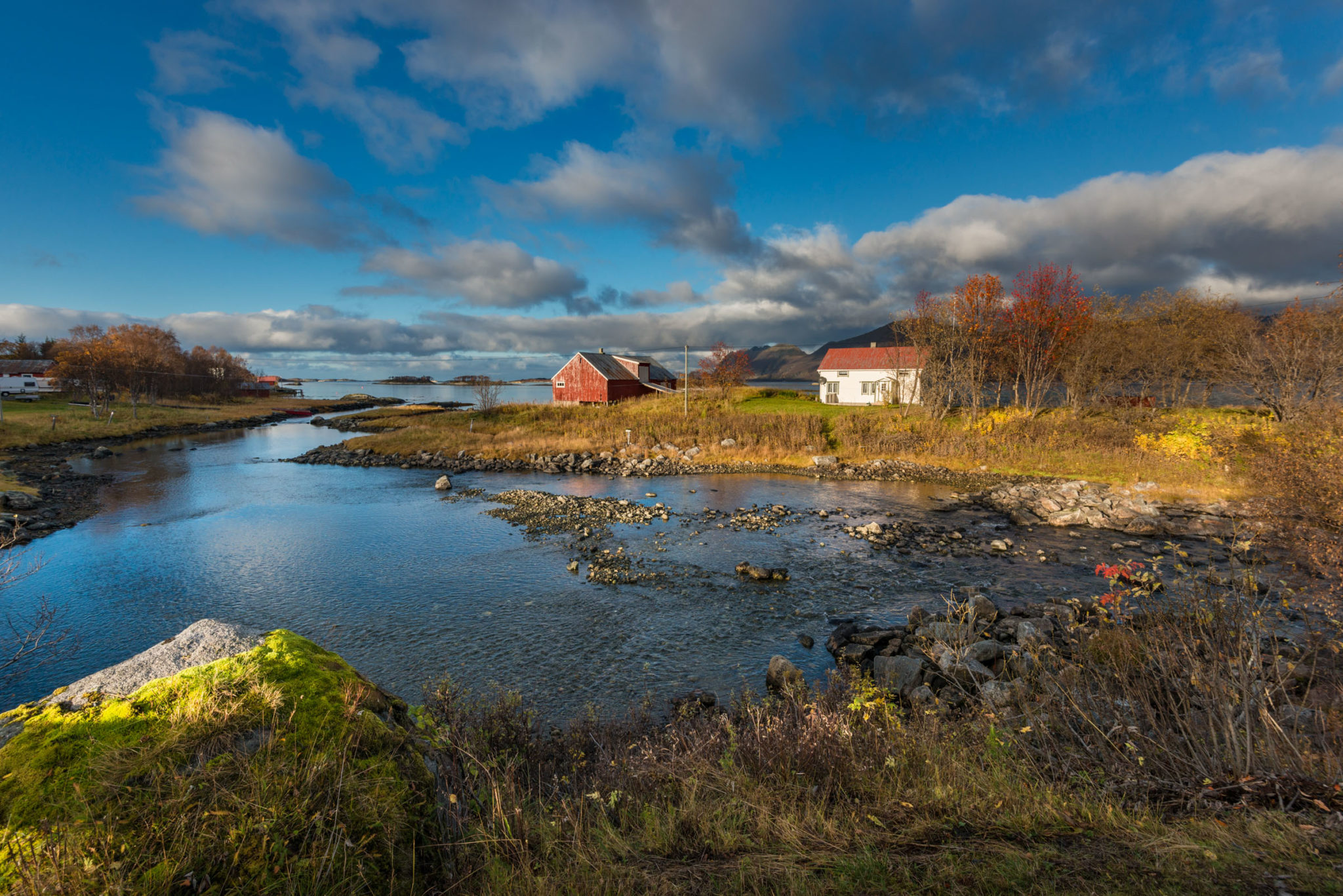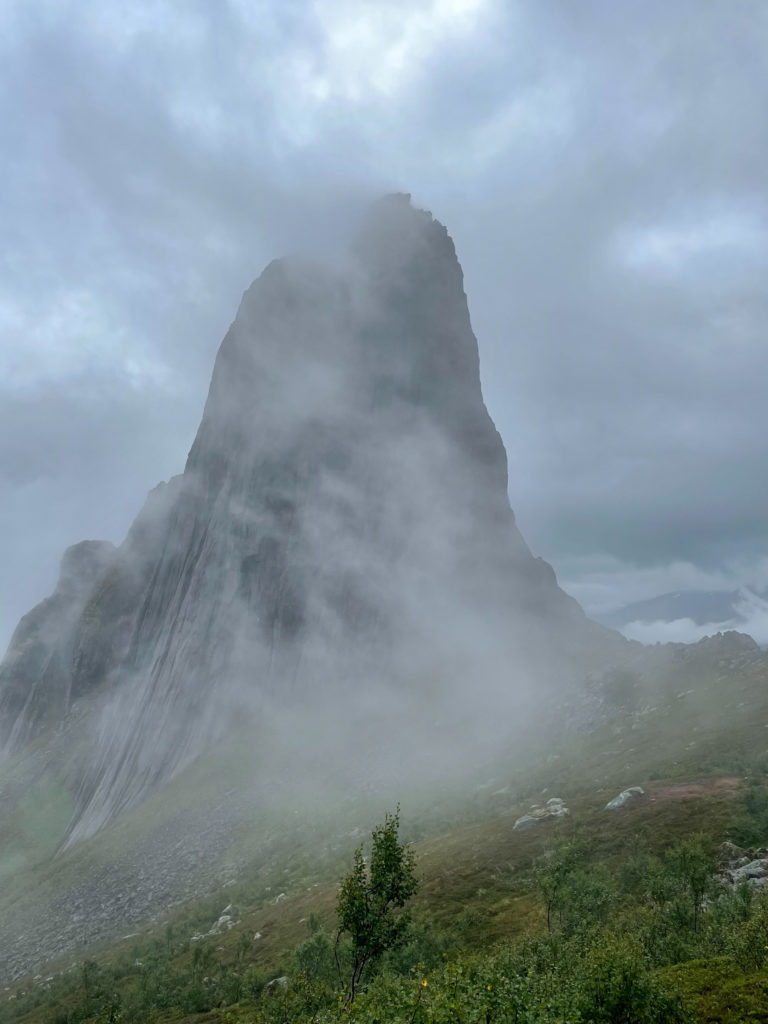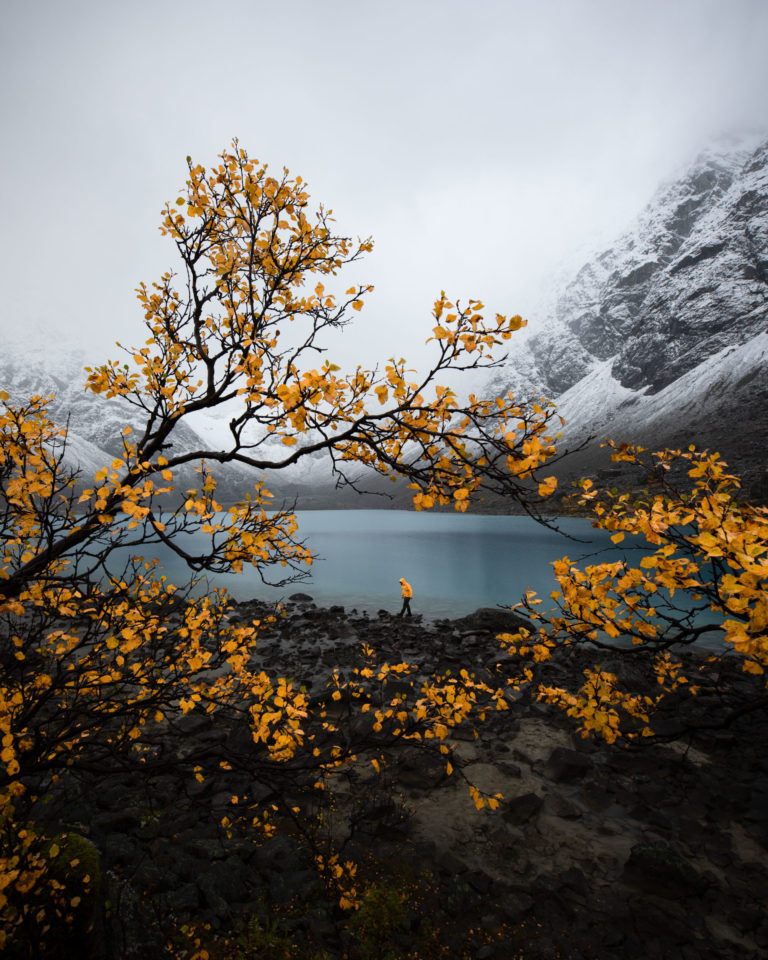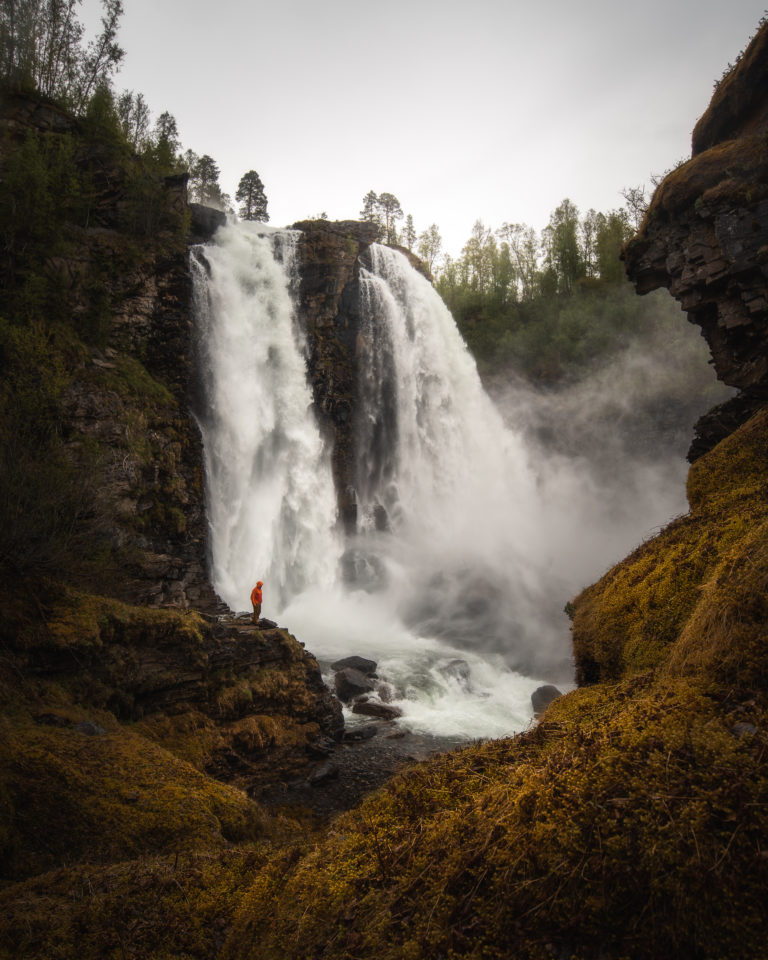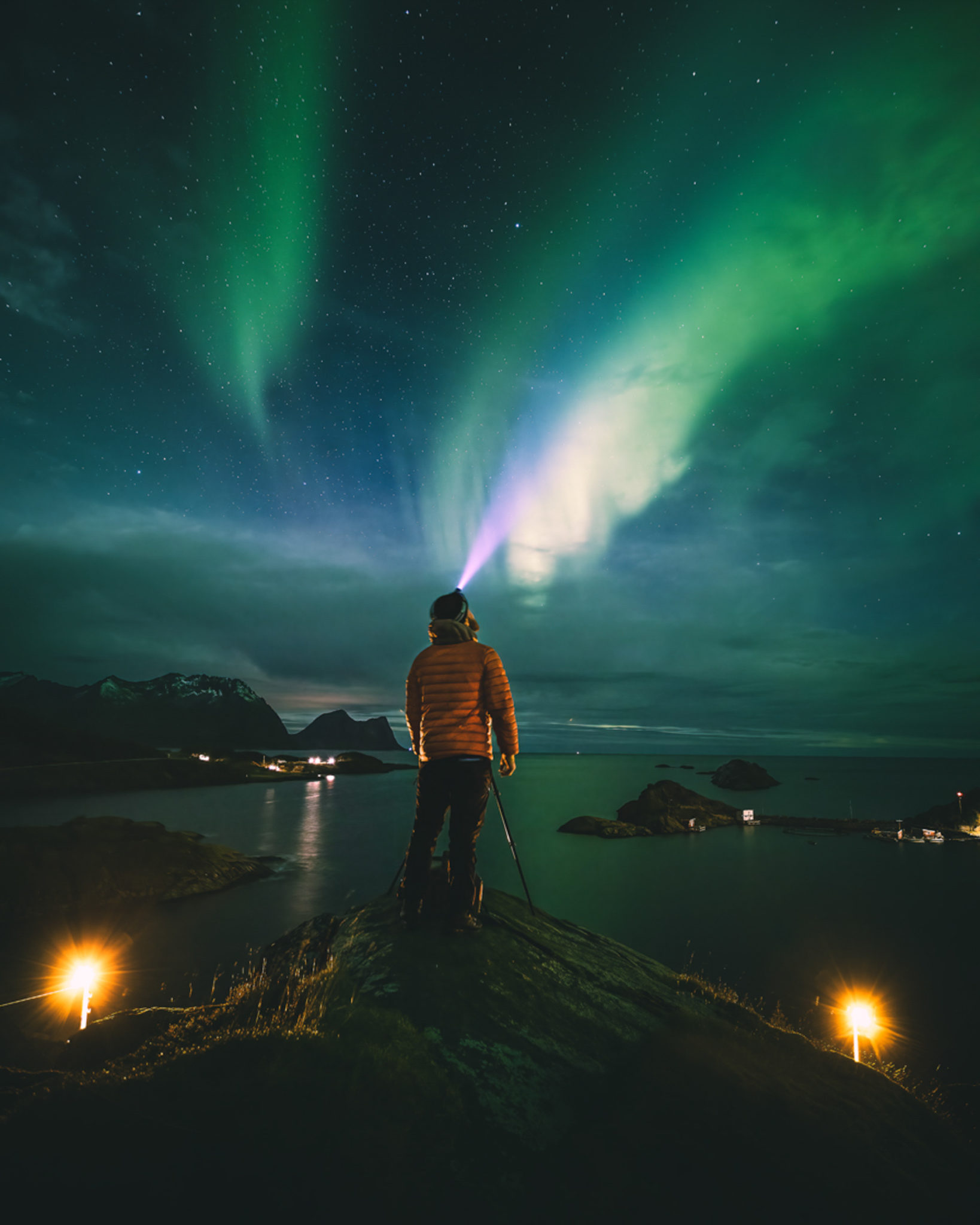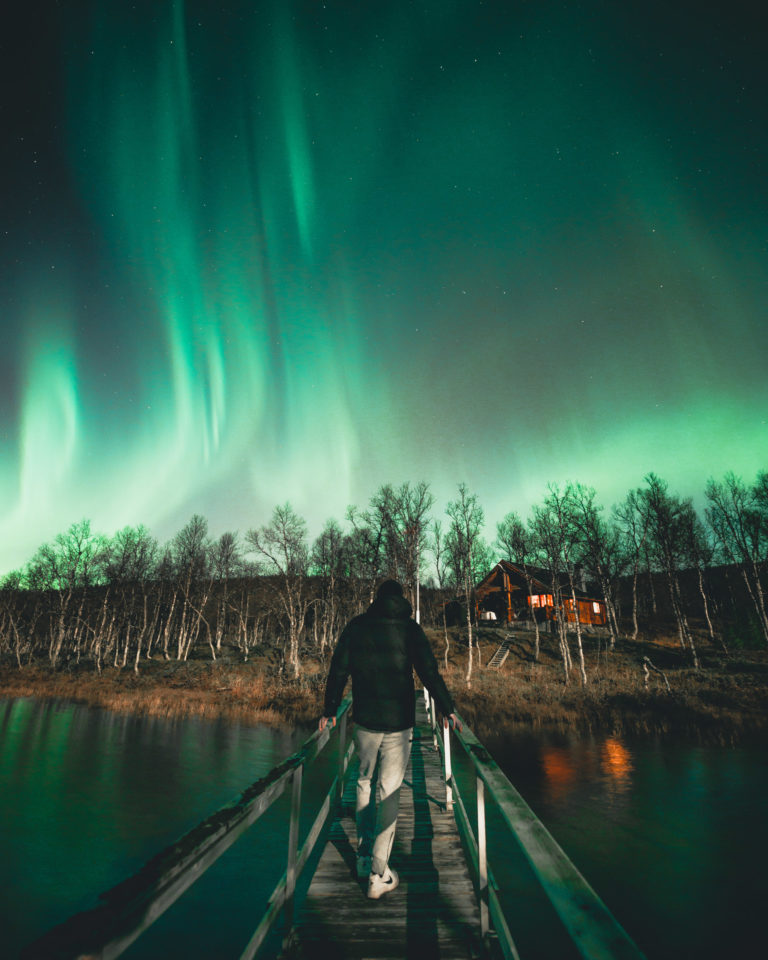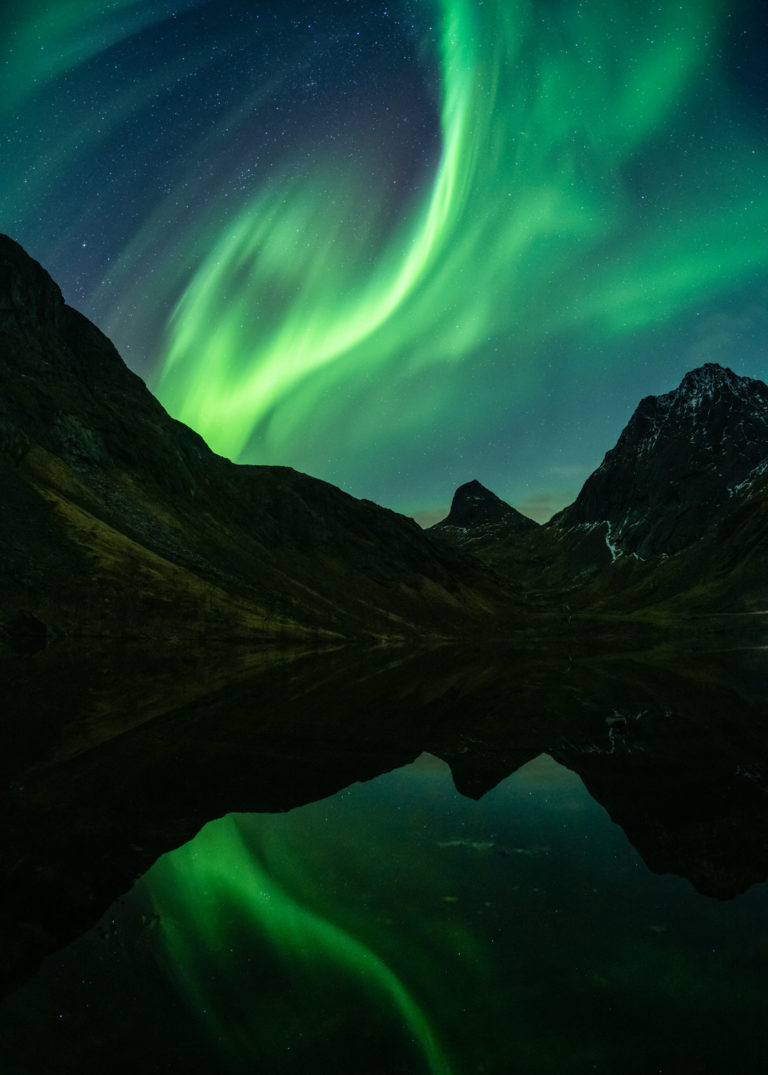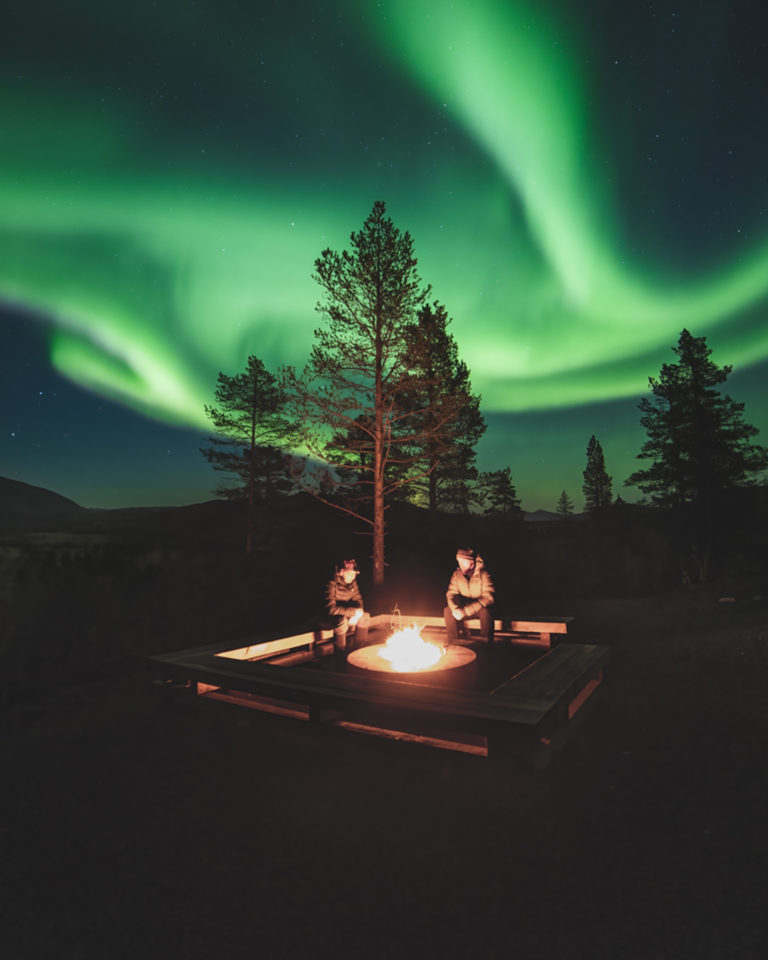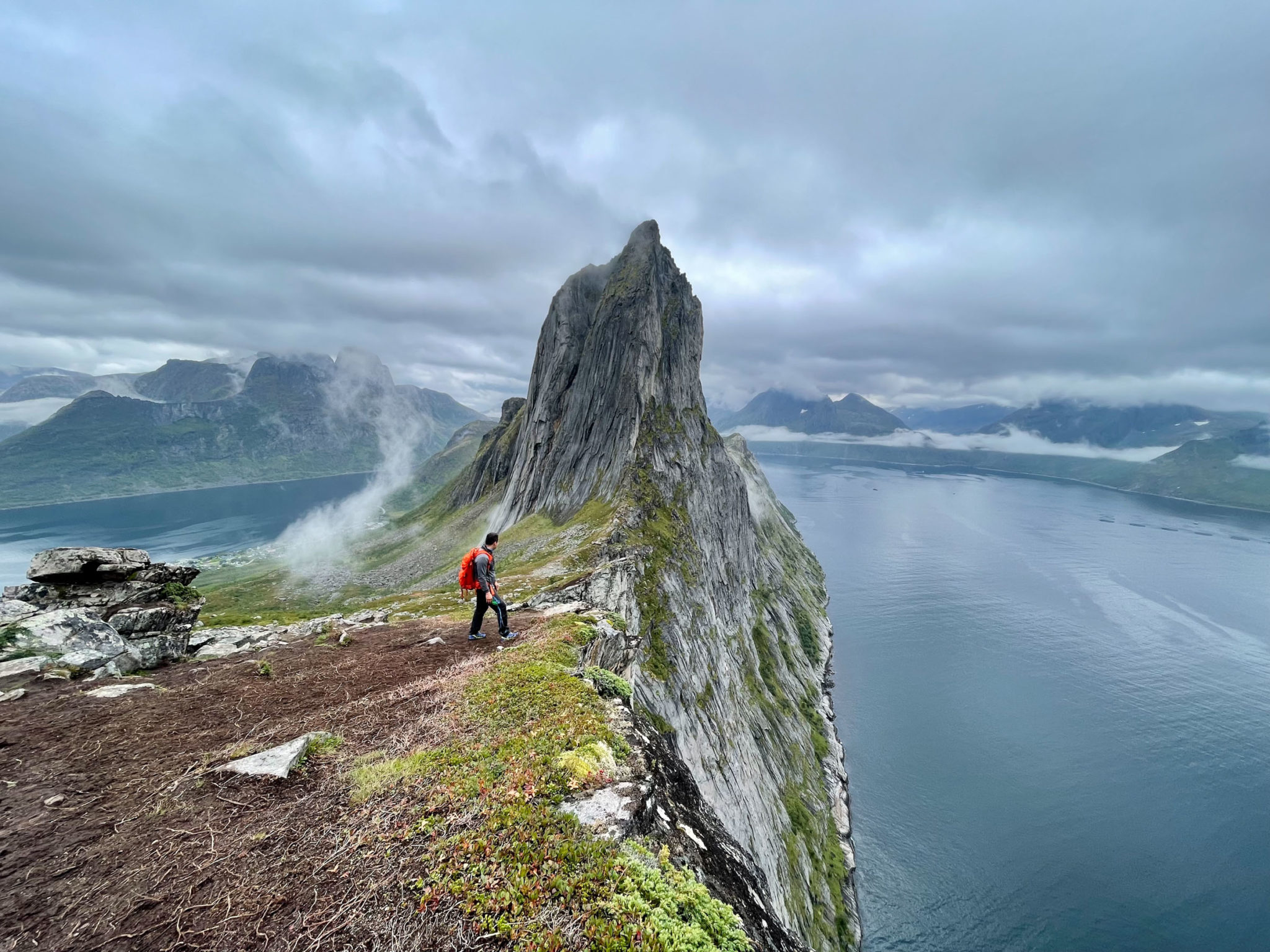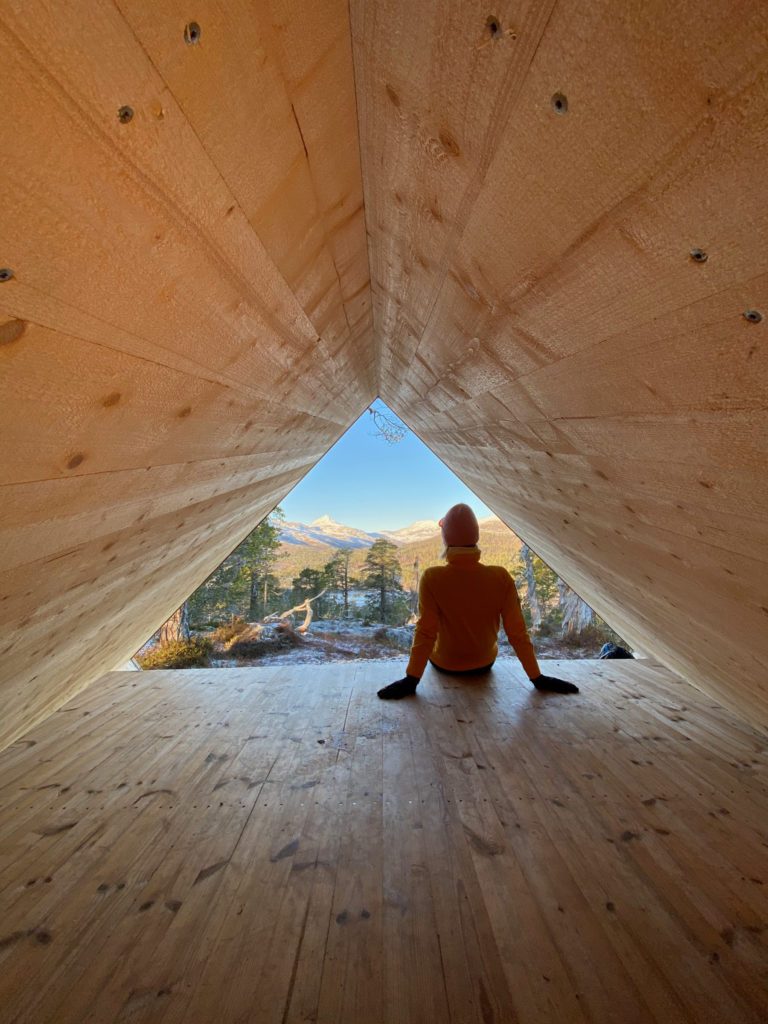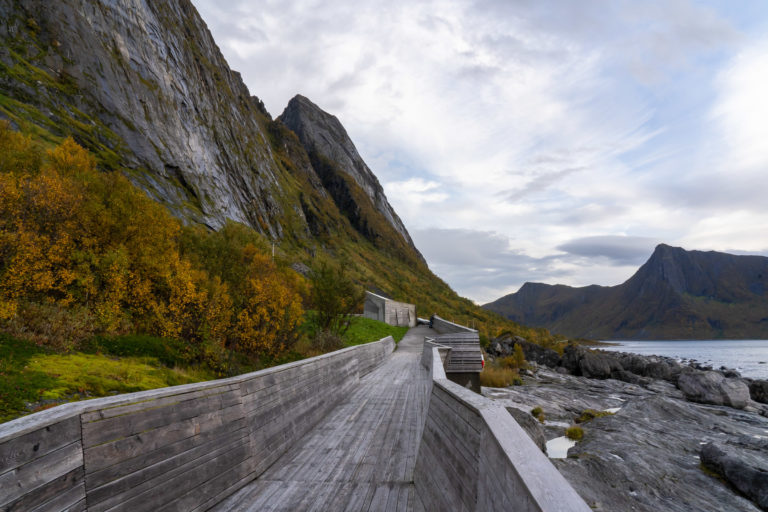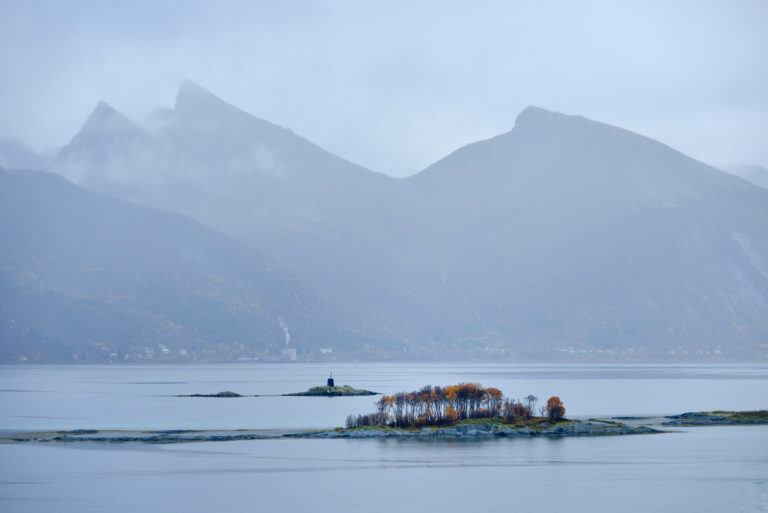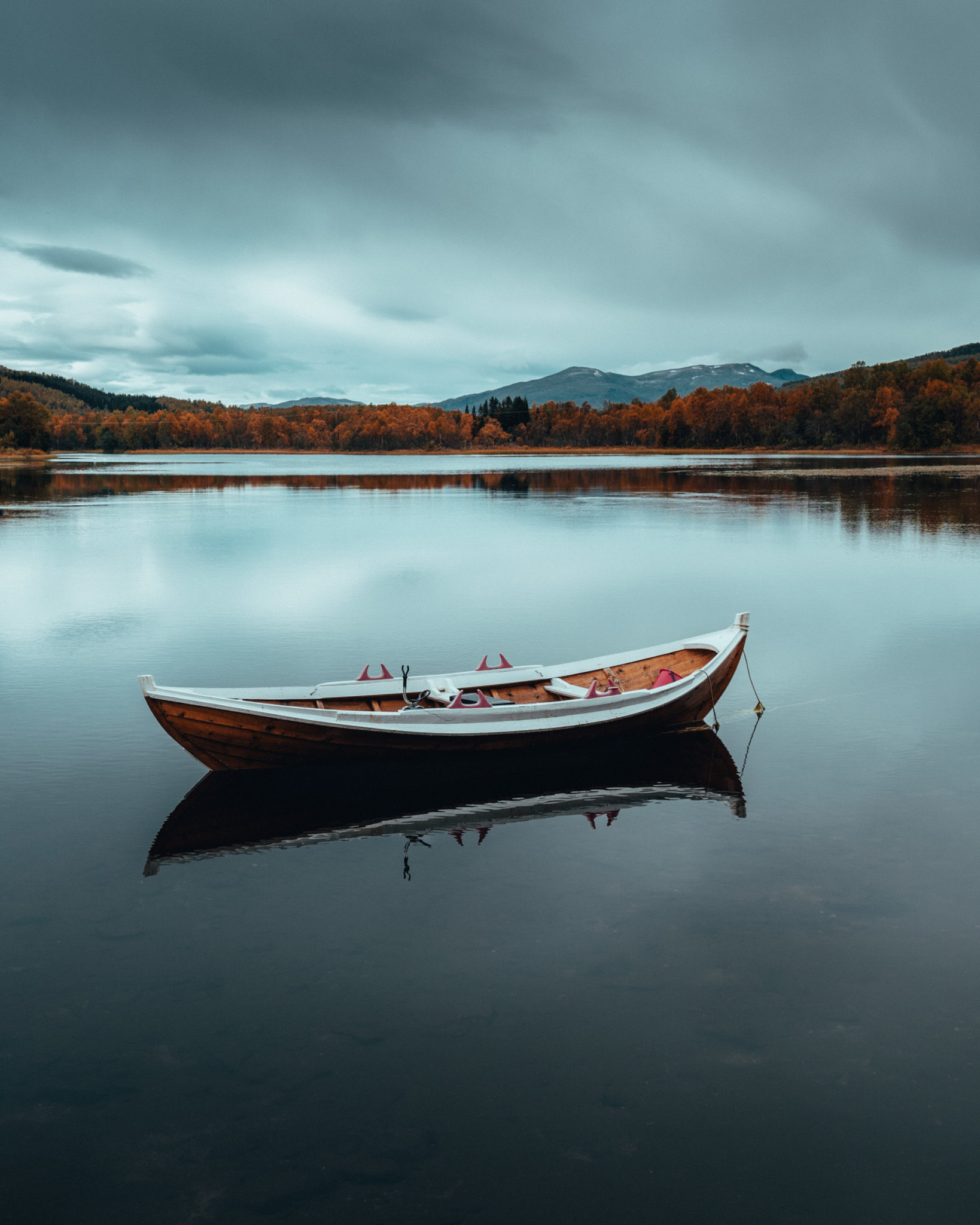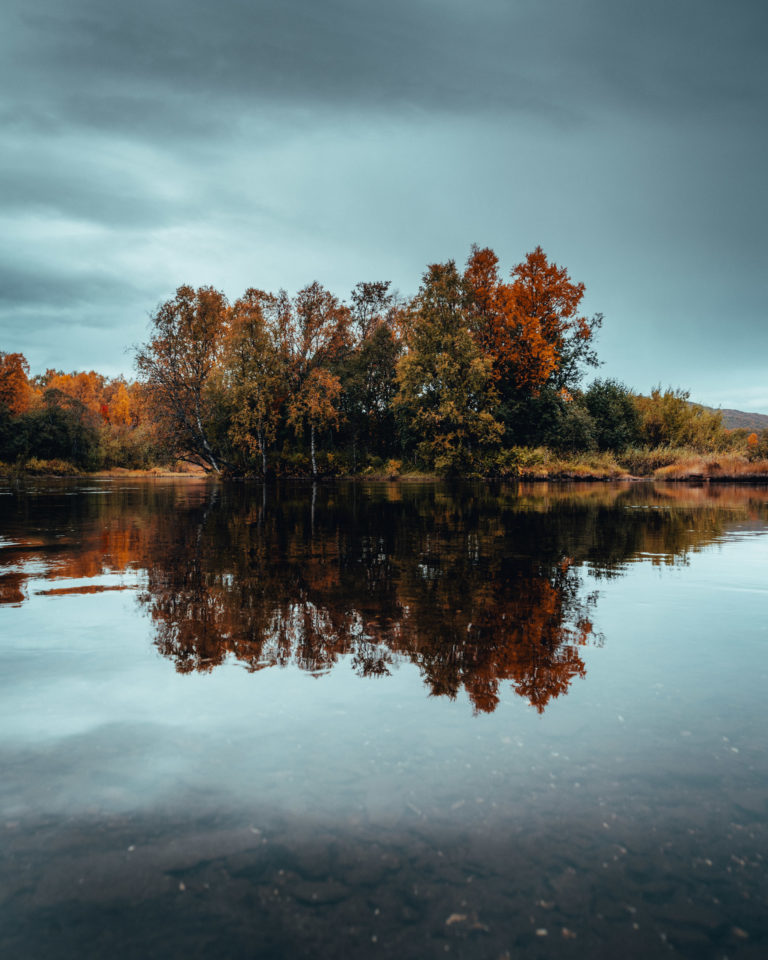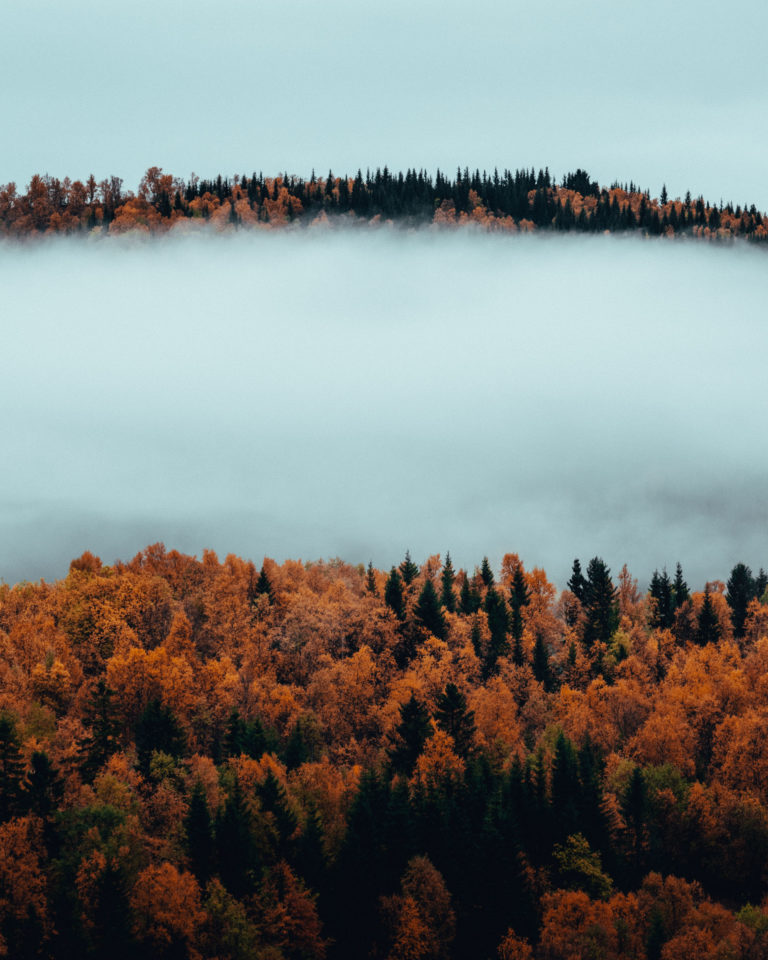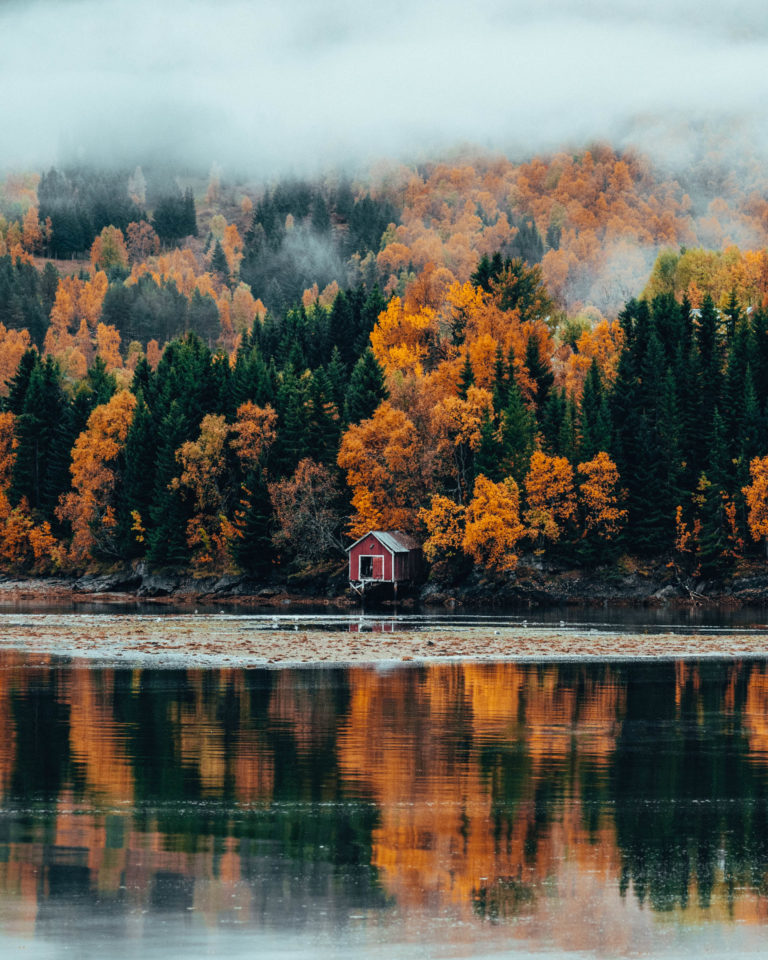An island of wild coasts, colourful forests, picturesque fishing villages and majestic peaks await you 300 km inside the Arctic Circle. As the locals know, autumn is the most beautiful time to see it
Senja is a capsule – continent, with endless landscape variety on an area the size of Greater London. The drama on the outer coast feels like a different world from the forested friendliness of the inland. If you have a few days in autumn, Senja is beauty, fresh walks, a bit of fun on the water and plenty of cosy relaxation. Maybe the Northern Lights show up too?
The outer coast is where the autumn storms hit
Wild, rough, stormy and untamed; the outer coast of Senja dives directly into the Atlantic from nearly a 1000 metres. Hard and rocky outcrops, sandy beaches, monumental, dark cliffs, and impressive peaks are found in every direction. Your glance is drawn towards the west, to the endless horizon and the ever-changing play of the clouds. In September, the creeping heather and low-grown shrubbery dresses for autumn against a backdrop of black rock, irresistible to every camera lens.
The Norwegian Scenic Route meanders along the coast
There is a road following this outer coast, narrow and winding, with a new breath-taking view around every bend. Part for the Norwegian Scenic Route programme, they have architecturally designed viewpoints and monumental toilets. Some of the compact fishing villages are busy and hard-working, others are peaceful and lost in time. All invite to a stroll with the camera.
Senja has a friendly side
Cross the coastal ridge – it can take you twenty minutes – and there is a different Senja. Light birch forests, little streams and lakes and farmland along the Gisundet waterway; it looks friendly and welcoming. The south coast of the Island is full of sheltered coves and sandy beaches, inviting to strolls along calm seas.
The Ånderdalen National Park is instant wilderness
Untouched wilderness is found in the small national park of Ånderdalen. Here, small-grown pine trees with bonsai-like twisted branches grow around Lake Åndervatn. Follow the tracks up to the bare hillsides and up to the mountains and to the step descent into the Selfjord on the ocean side. You can spend days in the park, but beautiful parts are easily accessible even for the Sunday walker.
Dyrøy is a garden of Eden
A surprise this far north is the green island of Dyrøy and the adjacent mainland, found along the inner waterway. The rounded hills are clad with birch forests, shining in every shade of yellow-orange in the autumn. Farms line the shoreline, and it’s all calm and peaceful. Use the day for a walk along the shoreline, and the evening to look for Northern Lights over the treetops.
Hiking is best in the autumn
It’s a well known fact in the north: The autumn is the best time to hike. The air is crisp and refreshing, and on clear days you can see far away. Lakes and streams are clear and transparent, mirroring the foliage changing from deep green via orange to all gone. Around Senja and Dyrøy, there are plenty of paths to small viewpoints affording a great view of the area.
Get a taste of salt water
On this island, the sea is everywhere. The 98 islands dotting the Bergsfjord on the ocean side, the calmer waters along the friendly southern coast and the sheltered Gisundet straight are all suited for kayaking. Far less strenuous is cruising around the archipelagos with a rib boat, reaching distant, inaccessible beaches and islets. You can also go out by boat to fish on organised tours.
Follow the tracks of history in Senja
In a landscape as grand as Senja, the traces of human history seem modest. However, look closely and you see some pearls. The island of Tranøy, off Senja’s southern coast, is an old trading centre, and the church from 1773, surrounded by the red-painted vicarage. Another little gem is the church of Torsken from 1784. In the valley of Kaperdalen, there is a cluster of old turf huts used by the local Sami community. Lovely Gibostad is an old trade centre on the Gisundet waterway, and Mefjordvær is a picturesque fishing village with a lot of old houses.
The autumn northern lights can come in August
Senja is right under the Northern Lights Oval, the zone on the globe with the most Northern Lights. The frail lights are completely outdone by the midnight sun, but sometimes around mid August, you can be lucky to spot them. Night by night, the chances increase, and by mid September, the chances are as good as in the middle of winter. So, with a bit of luck, you can see a big eruption with a mild föhn breeze in your hair. What a difference to the frozen winter!
Where do you see the Northern Lights in Senja
The altitude of the Northern Lights is usually above 120 km, and a biggie can be up to 800 km up in the atmosphere. On a clear night, it is consequently of no importance where in the area you happen to be. However, clear skies are of the essence, and that is by no means guaranteed. The intricate topography of Senja creates a lot of microclimates, though. If heavy clouds come in from the sea, you might still have pockets of clear skies in the inland valleys. A steady wind from the inland makes the outer coast the best place. Being mobile is therefore the best.
How to see the Northern Lights in Senja
On a clear night in autumn, you can simply go for a walk around where you’re staying. If you stay in a small community in Senja, there are usually few other light sources. If possible, walk along the beach rather than along the road. Wear something reflective to be seen by cars. if you walk along the road. With a headlamp, you can also walk on a forest path and even make it to a mountain top. There are also Northern Lights guides in Senja. If the skies are not clear, and you really want to try, having a car is great. Then you can attempt to find a place behind the next mountains with clear skies. Your accommodation can often be consulted for advice.
What do you do on an autumn evening?
When darkness falls on Senja Island in the autumn, entertainment is primarily looking out for the Northern Lights, studying the night sky or even curling up in the sofa listening to wind and rain. Light a candle, sip some tea and relax, we hardly have time for that these days. There are also some good eateries in small places in Senja, and they typically serve up local fare like fish and mutton. Since their opening times can vary through the week, we suggest you plan a little bit ahead and maybe make a reservation. Local pubs tend to be open in the extended weekend, and are low-key, cosy affairs. Finnsnes, the only town in the area, has a bigger selection.
Where do you stay in Senja?
The accommodation par excellence in Senja is hiring a rorbu. A rorbu can be a simple fisherman’s shack, but in Senja you typically live in purpose-built modern huts with all mod-cons. There are also simpler budget alternatives as well as more basecamp’ish places where activities are organised. Finnsnes – the modern town at the Senja bridge, has a couple of hotels that can serve as starting points for exploration on the island and the adjacent mainland side.
Organising your trip
Senja’s numerous activity companies can help you organise fun and interesting activities. Finding the best place to stay for you and your lot is of course essential. Opening hours of museums etc. could also come in handy. All this is found at one website, the local tourist organisation Visit Senja Region.
What kind of weather can you expect?
Senja is heavily affected by the Golf Stream, and the autumn is mild with entertaining weather. The last days of August and the first of September can be sunny and summery. Later, crispy clear days with mild temperatures can be followed by bitingly cold nights. On the other hand, an ocean warmed by summer can send wind and rain to the outer coast of Senja. You may also wake up to an early snowfall in September, but by midmorning it’s all gone. More stable snow can sometimes occur on the mountain tops in September, but it’s never deep. Pack water-resistant outdoor clothes, woollen underwear, a hat and gloves. Your shoes should be able to handle rain, wet terrain and slippery autumn leaves.
Combine Senja with Harstad or Tromsø
The island of Senja is peacefull bliss and pure nature. To add a bit of liveliness to your voyage, you might want to combine with the Arctic metropolises of Harstad (some 25000 inhabitants) or Tromsø (some 78000). Harstad is known for its good food, its ambitious culture calendar and the sense of history at the Trondenes peninsula. Tromsø’s lively downtown, merry night scene and interesting history of arctic exploration.
Practical about Senja
Visit Senja Region has it all on their website
Visit Senja Region has the full overview on their website.
The restaurants in Senja are small and full of character, and very popular with the locals. However, there are not that many of them, and some are open only some days of the week. You should thus plan a bit with the help of Visit Senja’s restaurant overview.
Fly SAS or Norwegian to Bardufoss (BDU). From there, there is an airport bus to Finnsnes. From Finnsnes there are local buses everywhere. You can also pick up a rental car at the airport for increased flexibility, although you should prebook it. Since Tromsø (TOS) is an airport with more flights, and sometimes more discount tickets available, Tromsø can also be a good solution, especially if you want to spend some time there too. A third airport that could come in handy, is Harstad/Narvik (previously known as Evenes, EVE). This is of particular interest if the city of Harstad is included in your plans. Do remember that both airlines sell discount one way tickets. This means you can travel into Tromsø and out of Bardufoss, notably.
There is a catamaran boat 2-4 times a day to Finnsnes. From there, you can either drive or take a bus to various destinations in Senja. There is also a catamaran from Tromsø to Lysnes on north-eastern Senja, with onward bus connections to the outer coast. Finally, you can also drive from Tromsø to Brensholmen and take the ferry from there. Troms Fylkestrafikk has got the overview.
From Harstad you can take a catamaran to Finnsnes 2-4 times a day. Furthermore, there is a catamaran calling at Skrolsvik on Senja’s southwestern corner on its very scenic way around the islands between Harstad and Senja. Troms Fylkestrafikk has all the hours.
